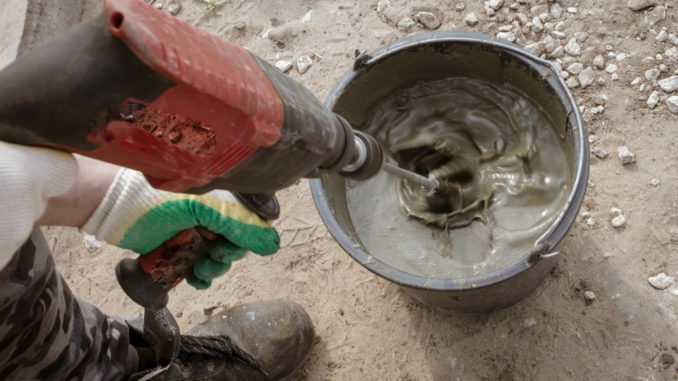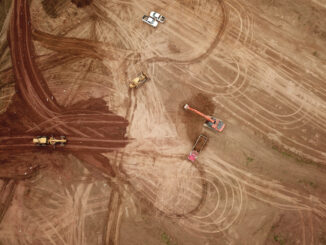
The concrete mixture is critical for most concrete properties and these details need to be considered in the mix design. During this planning stage, various factors need to be evaluated: workability, durability, strength, economy, and placement conditions. The information in this article will help with the selection of concrete ingredients as well as the sequences of activities that are necessary for the mix design. Additionally, specific methods can be used to optimize the aggregates with the goal of achieving optimal grading.
deTwo common phases are used in the planning process:
- Mix Design: During this phase, the required properties of the concrete mixture need to be identified. The planning includes the evaluation of intended use, exposure conditions, and geometry.
- Mix Proportioning: In this step, the quantities of ingredients are determined to ensure the requirements are met. Usually, the goal is to maximize economy and the necessary properties at the same time.
Development Sequence for Concrete Mixtures
Before construction begins, the mixtures are planned to match the construction system, environment, and loading that are anticipated for the job site. Various factors can affect strength and durability, including the air entrainment, workability, temperature, and permeability. Keep in mind that durability isn’t necessarily a function of strength, which is why many factors need to be evaluated to include non-strength-related concrete properties.
Once a plan is created, then a series of trial batches can be designed to test the job-specific materials. These test batches should include possible placement temperatures as well as ingredients that will be added to the mix. If needed, adjustments can be implemented so that the workability in the field can be completed with confidence.
Next, the batch testing moves to a full-scale process in the field. These field trials can be done using portable plants. This batching process should match the anticipated paving operations, including the mix time and other factors that will affect the concrete. Multiple testing points for workability can be implemented to simulate transportation time.
Following this step-by-step process creates an opportunity to adjust the mixture while minimizing risk. When the batching process is in the field, air content and workability are the two concrete properties that can be manipulated at this point.
Optimization of Aggregate Grading
The concrete mixture can be enhanced by optimizing the grading with the combined aggregates. Generally, the aggregates are dimensionally and chemically stable, which is why it is preferred to maximize aggregate content and minimize the cement paste that has higher chemical reactivity. When the space is well-aggregated, it decreases the space that needs to be filled in with cement paste.
Shilstone uses a combined grading analysis for specifying and selecting the mix proportions. Three tools can be used to optimize the aggregate grading:
- Coarseness Factor Chart (CFC): Creates an overview of the mixture using mathematical calculations to separate three size groups (coarse particles, intermediate particles, and fine particles).
- 45 Power Chart: This chart is used to show trends and describe the ideal combine grading. The chart is created based on sieve sizes plotted on an X axis. Then, the aggregate is passed through the sieve and compared to the measurement on the 0.45 power chart. If the comparison deviates from the line, then it means that the project is deviating from the optimum.
- PARS – Percent of Aggregate Retained on Each Sieve: This graphic shows the percent of aggregate that is retained for the sieve size. It is common to find a deficiency in the retained particles. Two adjacent sieve sizes tend to be balanced, while three adjacent deficient sizes mean there is a problem that should be corrected.
Mixture Portion Calculations
Before the trial batches are completed, a starting point can be determined by using desktop calculations of the mix proportions. Not only is the math used in these calculations, but it can also be helpful to tap into historical data and field experience.
While several calculations can be used for mix proportions, the Absolute Volume Method is a common calculation to use. The Absolution Volume Method Includes 12 Steps:
- Concrete Strength: Durability and structural requirements are evaluated to determine the specified strength of the concrete mix.
- Water-Cementitious Material Ratio: This is known as the w/cm ratio, which is the mass of the water divided by the mass of the cementitious materials. Unlike a water-to-cement (w/c) calculation, w/cm calculates only the mass ratio of water with the supplementary cementitious materials that will be added to the concrete.
- Aggregates: The proportion of the concrete mixtures are affected by the distribution, particle size, porosity, shape, and surface texture of the aggregate. These characteristics need to be considered because they affect the water demand and workability of the concrete.
- Air Content: Air entrainment is important since the concrete will be exposed to cycles of thawing and freezing. The size of the aggregate and the severity of exposure will affect the amount of air required.
- Workability/Slump: Job placement conditions will determine the necessary consistency, workability, and plasticity for the concrete. A slump test can be used for the measurement of concrete consistency.
- Water Content: Various factors influence the amount of water required for the concrete mix, including the slump requirements, aggregate size and texture, air content, cementitious material, and temperature. Water-reducing admixtures can be incorporated if water content needs to be reduced.
- Cementitious Materials Content: This content can be calculated when the water content is divided by the water-cementitious materials (w/cm) ratio.
- Cementitious Materials Type: Some mix designers complete this step first since the selected materials can influence the previous steps. Special requirements need to be considered, such as low-heat requirements, alkali-silica reactivity, and sulfate resistance.
- Admixtures: Admixture quantities are calculated to achieve the desired water-reducing and air effect. Chemical admixtures change the concrete air content and water requirement and need to be factored into the mix proportions.
- Fine Aggregate: After the quantities of water, air, coarse aggregate, and cementitious materials are determined, then the fine aggregate amount is identified. The absolute volume method is used based on the relative density (specific gravity) of the material.
- Moisture/Absorption Correction: Corrections are often required due to compensation for moisture on and in the aggregates. All aggregates will contain a measurable amount of moisture, which is why mixing water needs to be added to the batch based on the amount of free moisture that comes from the aggregates.
- Trial Batches: In this final state, the batch weights are checked in both laboratory tests and field batches. It is important to mix enough concrete so that the necessary tests can be completed, including air and slump tests, compressive-strength tests, and flexural tests if required.
Adjusting Properties
The required concrete properties can be achieved, but it might require adjustments to the selected materials, proportions, or other concrete mixing factors. Here is an overview of adjustments that can be made to achieve desired properties:
- Workability: Including stability, compatibility, mobility, and freedom from segregation based on job Adjustments might include water content, the proportion of cement and aggregate, admixtures, aggregate properties, cement characteristics, time and temperature.
- Stiffening and Setting: These rates are critical since they affect the ability for the concrete to be placed, finished, and sawed. The goal is to avoid blemishes on the surface and cracking throughout the concrete. Setting and stiffening are affected by cementitious materials, chemical admixtures, aggregate moisture, temperature, and water-cementitious materials.
- Bleeding: This development of a water layer on concrete that is freshly placed happens because of the settlement of particles and upward movement of water. Bleeding can be prevented or minimized by reducing the slump, ratio of water-cementitious materials, and water content. An increase in the cement of supplementary cementitious materials in the mix can be beneficial. Also, the aggregate needs to be properly graded, and chemical admixtures can be used to reduce bleeding.
- Air-Void System: This fundamental aspect that affects concrete durability. These adjustments affect the control of the air-void system in a concrete mix: alkali content, fineness in cement, supplementary cementitious materials, aggregates, and workability.
- Density (Unit Weight): Density is used as an indicator of batching consolidation and uniformity. It is affected by the material density in the mixture (mostly from the coarse aggregate), air content, aggregate moisture content, and relative proportions of the materials and water.
- Strength: Requirements for strength need to match the intent of the design, and are influenced by the ratio of water-cementitious materials, cement chemistry, SCMs, chemical admixtures, aggregates, and temperature.
- Volume Stability: Volume changes (contraction and expansion) occur in concrete due to moisture and temperature variations. It is important to minimize the change in volume to reduce the risk of cracking. This can be achieved with the following considerations: paste content, aggregates, and curing.
- Permeability and Frost Resistance: Permeability affects the durability of the concrete mixture. Lower permeability can be achieved by increasing the content of cementitious materials, reducing the ratio of water-cementitious materials, using supplementary cementitious materials, using good curing practices, using materials that are resistant to the anticipated chemical attack, creating a satisfactory air-void system, and selective aggregates with a history of resistance to D-cracking.
- Abrasion Resistance: This factor is important to maintain the skid resistance of the pavement. Improvements include: choosing hard and dense aggregates, increasing the compressive strength, and increasing the curing time.
- Sulfate Resistance: If the concrete will be exposed to high sulfate compounds, then adjustment might be required: reducing permeability with w/cm ratio, choosing a sulfate-resistant cement, adding Class F fly ash, using 20 – 50% GGBF slag, or using more supplementary cementitious materials.
- Alkali-Silica Reaction: Avoid this problem with some of these adjustments: choosing aggregates with historical performance, using low-alkali cement, using supplementary cementitious materials, using lithium admixtures, blending non-reactive and reactive aggregate.
What are the key considerations in the mix design process for developing concrete mixtures?
Workability, durability, strength, economy, and placement conditions are critical factors evaluated in the mix design process to ensure optimal concrete properties.
How is aggregate grading optimized in the development of concrete mixtures, and what tools are commonly used for this purpose?
Aggregate grading is optimized using tools such as the Coarseness Factor Chart (CFC), 45 Power Chart, and PARS (Percent of Aggregate Retained on Each Sieve), ensuring a well-aggregated space and minimizing the need for excessive cement paste.












































